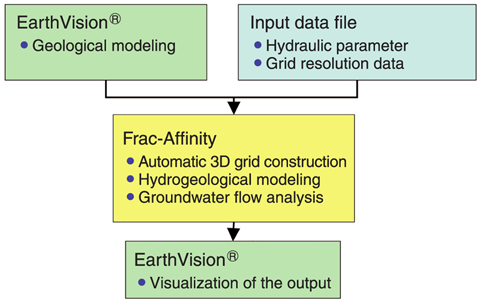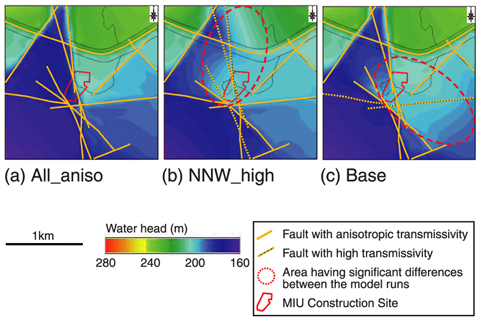
Fig.2-15 Working flow of GEOMASS system

Fig.2-16 Hydraulic head distribution based on result of sensitivity analysis
For research and development of geological disposal of high-level radioactive waste, it is important to improve the methods of evaluating groundwater flow deep underground. For characterization of groundwater flow, modeling of faults and fractures are particularly essential because these geological features have a significant effect on the groundwater flow in the rock mass. However, significant time and effort is also required for modeling and analysis as the complexity of the geological and hydrogeological environment increases. To deal with this problem, the GEOMASS (Geological Modelling Analysis and Simulation Software) system has been under development since 1997. A simplified work flow diagram of the GEOMASS system is shown in Fig.2-15. In the system, 3D geological models development by EarthVision![]() are integrated with automatic numerical analysis, including groundwater flow simulations and hydrogeological grid generation, by Frac-Affinity.
are integrated with automatic numerical analysis, including groundwater flow simulations and hydrogeological grid generation, by Frac-Affinity.
In the MIU Project (Mizunami Underground Research Laboratory Project), based on the results of the surface-based investigation, and construction phases, geological and hydrogeological models have been revised and groundwater flow simulations have been carried out using the GEOMASS system.
Sensitivity analyses using the revised models were carried out to evaluate the impact of the hydraulic properties of faults on groundwater flow in many simulation cases varying the permeability of faults. Examples of the results are shown in Fig.2-16. It is clear that hydraulic head distribution is significantly influenced by permeability of faults and therefore, that faults are a major influence on groundwater flow in the deep underground. The GEOMASS system provides users with important and uncertain factors, after which the main issues for further investigation can be identified through modeling and simulation work.
Moreover, groundwater flow analysis can be carried out to predict the inflow rate of groundwater into the shafts and galleries as excavation progresses and thus can provide a comparison between predicted and measured inflow rates. These results can rapidly and effectively be input into the design of shafts, galleries, water treatment facility, and so on.
The GEOMASS system allows users to reduce time and effort for geological and hydrogeological modeling, groundwater flow simulations, and modification of models. This capability of the GEOMASS system enables the integration of the investigations and the construction of the geological environment models during shaft excavations. Confirmation of the applicability and accuracy of the GEOMASS system for site characterization will continue, and modifications will be made to this system according to need.